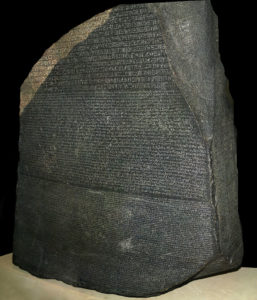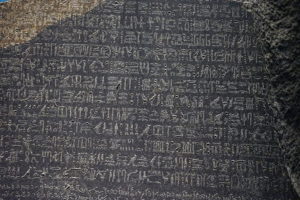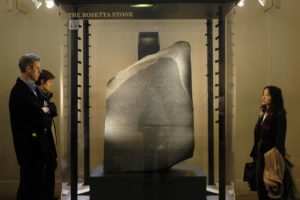-
The Ancient World
- Building Societies – What Does it Take? – Lesson
- Building Societies – What Does it Take? – Quiz
- Athens, Rome, and Jerusalem: Where Western Civilization Began – Lesson
- Athens, Rome, and Jerusalem: Where Western Civilization Began – Quiz
- Persia: Where Fake News Began? – Lesson
- Persia: Where Fake News Began? – Quiz
- Tell Brak: The World’s Most Ancient City? – Lesson
- The Key to Ancient Egypt: Rosetta Stone 200 Years On – Lesson
- The Key to Ancient Egypt: Rosetta Stone 200 Years On – Quiz
-
World History
- Slavery: An Ancient Evil That Still Exists Today – Lesson
- A Tale Of Two Sacrifices – Part I – Lesson
- A Tale Of Two Sacrifices – Part II – Lesson
- The Story Behind the Israel-Palestine Conflict – Lesson
- Churchill Vs. Hitler: Standing Up for Europe – Lesson
- War, Peace, and School Bullies – Lesson
- Survey Says: Millennials and Gen Z Just Don’t Know the Holocaust – Lesson
- V-J Day: Celebrating 75 Years Since Japan’s Surrender – Lesson
- A History of Ukraine: Battleground for Empires – Part 1 – Lesson
- A History of Ukraine: Battleground for Empires – Part 1 – Quiz
- A History of Ukraine: Battleground for Empires – Part 2 – Lesson
- A History of Ukraine: Battleground for Empires – Part 2 – Quiz
- History of the Holy Land – Quiz
-
U.S. Allies and Rivals
-
Around the Globe Today
- Chinese Uighurs – What Is Going On? – Lesson
- A New Republic – Barbados Removes the Queen as the Head of State – Lesson
- A New Republic – Barbados Removes the Queen as the Head of State – Quiz
- Venice Makes a New Rule for Tourists – Will Other Cities Follow? – Lesson
- Venice Makes a New Rule for Tourists – Will Other Cities Follow? – Quiz
- Professor Lives Underwater for 100 Days – Lesson
- Professor Lives Underwater for 100 Days – Quiz
- Setenil de las Bodegas – The Spanish Town Built Under a Rock – Lesson
- Setenil de las Bodegas – The Spanish Town Built Under a Rock – Quiz
- Hat of Napoleon Bonaparte Sells for Over $2 Million at Auction – Lesson
- Hat of Napoleon Bonaparte Sells for Over $2 Million at Auction – Quiz
- The UK Plans to Measure Kids’ Bellies to Monitor Their Health – Lesson
- The UK Plans to Measure Kids’ Bellies to Monitor Their Health – Quiz
- Radioactive Wolves in Chernobyl – Lesson
- Radioactive Wolves in Chernobyl – Quiz
-
Politics and Economics Around the Globe
The Key to Ancient Egypt: Rosetta Stone 200 Years On – Lesson

Rosetta Stone (Photo by VCG Wilson/Corbis via Getty Images)
What is the stone’s significance?
The Rosetta Stone was discovered 223 years ago. While the stone was found in July 1799, it wasn’t until 23 years later that its carvings were finally translated, in 1822. The 200th anniversary of the translation has prompted new interest in this ancient relic. The anniversaries of both the Rosetta Stone’s discovery and translation serve as a reminder of how important this discovery was in figuring out the ancient world.
The stone slab is 112.3 cm long by 75.7 cm wide and 28.4 cm thick – or about 44 x 30 x 11 inches. Writing, or script, is carved into its surface, written in three different texts. One of them is Greek, and the other two are Egyptian. For years, it was unclear what was written on the slab and why it appeared in three languages. So, let’s discover the reason for the different writings and why the stone is so important.
History of the Rosetta Stone
The grey and pink granodiorite stone was first discovered in 1799 by Pierre François Xavier Bouchard, a French officer in Napoleon’s army. Bouchard found the artifact at Fort Saint Julien, in the city of el-Rashid (Rosetta) on the Nile Delta in Egypt. The slab was removed from a wall that was being demolished due to construction at Fort Julien. Bouchard’s commanding officer, General Menou, recognized the importance of the discovery and sent it to Alexandria, where casts and copies were made.

(Photo by: Universal History Archive/Universal Images Group via Getty Images)
Ultimately, the unique find would be confiscated by the British in 1801 when they defeated the French in the Battle of the Nile. Currently, the relic is on display in the British museum, among other Egyptian artifacts.
Deciphering the Message on the Stone
The three texts carved into the stone were identified as Hieroglyphic, Demotic, and Greek. Hieroglyphs were symbols used by ancient Egyptian priests and they were not commonly used throughout the area. Egyptian commoners used the Demotic script – the word “Demotic” is related to “democracy” and it means common or popular, meaning that it was used among the masses. It was later discovered to be a simplified form of Hieroglyphs. The Greek language was used for administrative functions.

Jean-Francois Champollion (Photo by: Prisma/Universal Images Group via Getty Images)
Scholars set out to translate the writing on the stone, hoping to unlock the mysteries of ancient Egypt. In fact, it was a competitive time, as the translators raced to be the first to figure out the meaning. Soon it became clear that each writing style delivered the same message as the others. That information helped French Egyptologist Jean-Francois Champollion decipher the hieroglyphic message on September 27, 1822. In doing so, Champollion virtually brought back a forgotten and unknown part of history.
“He used the Egyptian writing system as a gateway into ancient Egypt, so, by deciphering the hieroglyphs, he really unlocked an ancient civilisation that people didn’t really realise was there at all,” said British Museum curator Ilona Regulski.
What Does it Say?
The text describes the praise and gratitude the Egyptian community felt for their leader Ptolemy V. The king did several things that pleased the masses. For example, he gave money to build new temples and restore ones in need of repair. He reduced and ended unnecessary taxes. He released his enemies from prison and worked to improve relationships with his other adversaries.
The council of priests who wrote the text vowed that Egyptians would always show their appreciation to the great leader by placing a statue of the king wearing ten gold diadems in every temple with the title ‘Ptolemy Defender of Egypt.’ Additionally, the king’s birthday and coronation day would be celebrated every year with a festival. The 17th day of every month would also be dedicated to his honor. Ptolemy would forever be known as the greatest ruler of all time.
What’s Going on with the Rosetta Stone Now?

The Rosetta Stone in the British Museum of London. (Photo by Alexandre MARCHI/Gamma-Rapho via Getty Images)
For decades, Egyptians have demanded that the stone be returned to their country, but the British have not been convinced to give back the rock. The British Museum recently began a special exhibition displaying the stone, as well as other ancient Egyptian artifacts that helped in translating the ancient languages.
According to British Museum Director Hartwig Fischer, the exhibition “marks 200 years since the remarkable breakthrough to decipher a long-lost language. For the first time in millennia the ancient Egyptians could speak directly to us. By breaking the code, our understanding of this incredible civilisation has given us an unprecedented window onto the people of the past and their way of life.”